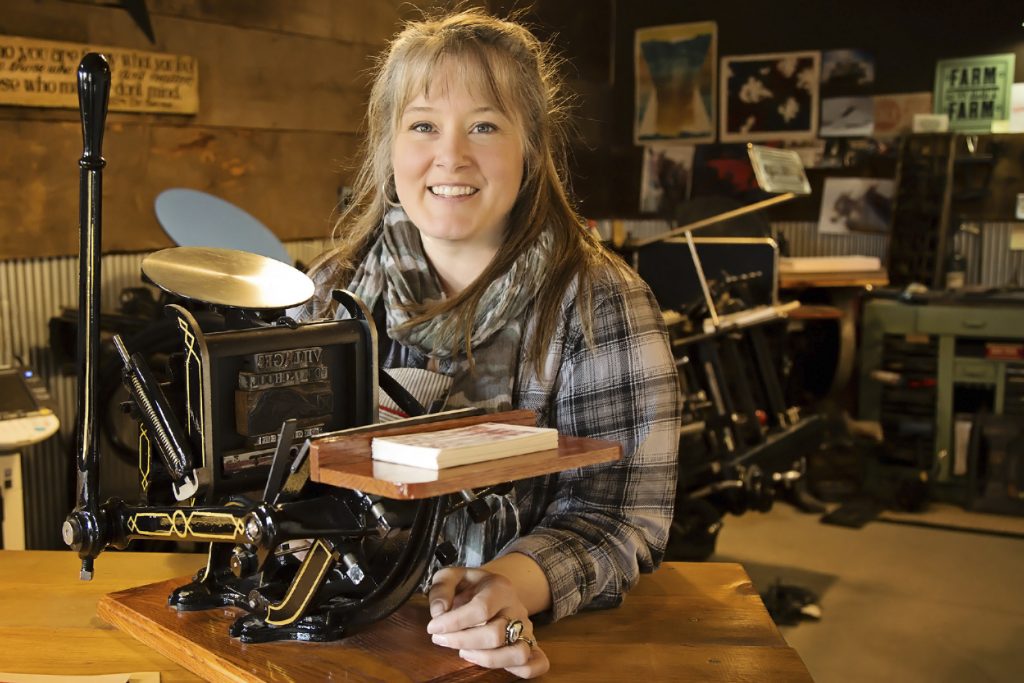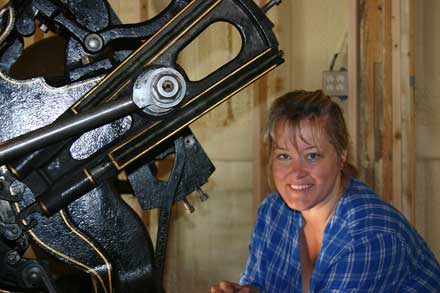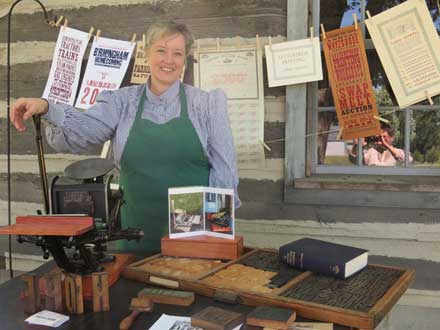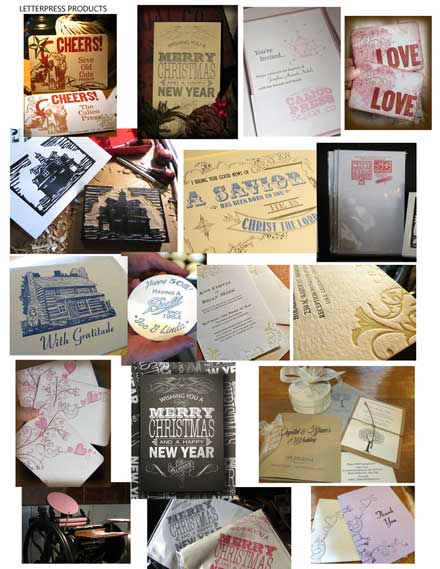
Picture, if you will, a female superhero of the Iowa kind: steely blue eyes, soft salt-and-pepper hair, broad shoulders, strong hands, and a clever mind. Instead of shiny armor or a cape, she dons a flannel shirt, jeans, and a pair of work boots. Her superpower is to make and preserve things of beauty. Her mission? Saving the antique printing press. Ladies and gentlemen, meet Melinda Stockwell, owner of the Calico Press.
She might think that my superhero comparison is overkill, but after meeting Melinda (Mel) for the first time, I suddenly felt the world was in better hands. Well, at least the world of printmaking and conservation in Southeast Iowa.
Among her many passions and countless talents, Mel has taken it upon herself to collect, and bring back from the dead, antique printing presses of the 1800s. Some of these machines are the kind you’d need 10 men to lift, the kind you manipulate with huge knobs, levers, and cast-iron wheels big enough to stick on a covered wagon. The kind with moving plates, blades, and rollers that could seriously mess you up if you didn’t know what you were doing. Machines that would likely survive a tornado . . . or, at the very least, the collapsing of a building.
But as sturdy as they are, these old platen presses are an endangered species. To most folks, the iron parts that comprise these massive machines have more value than the prints they produce or the history they hold. As time marches on, fewer and fewer people know how to restore, maintain, or use them—or care enough to learn—so these old dinosaurs are being sold for scrap at an alarming rate.

Having just heard about some 1800s printing equipment that Mel rescued from the Tribune Printing building in Fairfield before its collapse, I was excited to get a personal tour of the treasures at her historical letterpress shop, located just east of Birmingham. I was accompanied by my dad, Paul Siemsen, who studied graphic design, typography, and printing back when some of these old machines were more widely used. As we discovered, her stash is indeed impressive.
All told, Mel has eight printing presses, three proof presses, an etching press, and a lead type caster in her shop. It’s crowded but well organized, every inch occupied by machines, worktables, print samples, and huge cabinets full of wood type and old “cuts” (palm-sized metal engravings mounted on wood) that have been salvaged over the years. It’s a feast for the eyes—a small museum, really. She makes us feel right at home.
First on our tour was the 1875 Favorite (yes, that’s its official name), a tabletop press that Mel bought off a hayrack at a local auction. It’s a tiny thing, small enough to display on her front desk. Balanced on a center rail, the Favorite is an unusual design, and as far as she knows there is only one other like it in existence. It’s been de-rusted and brought back to full glory, finished with glossy black paint and gold pinstripes. “So that’s what I do,” she tells us. “I save old presses and then I restore them. And then I use them.” Cool.
The tour continues, and I begin to notice she talks about her presses like they are people. Not just people, but old friends. She turns to her left and puts her hand on the huge black wheel of an 1886 Chandler & Price.
“So this is kind of my baby. She and I are together a lot. She was in the basement of the old Des Moines Register building that flooded. . . . Somebody went down there and they said, ‘You know, those are parts for an old platen press over there, who should we call?’ And thankfully those parts ended up here.
“I got her all cleaned up and put back together, and I’ve been printing with her for about four years now. She’s my lady,” she says with affection. “She’s delicate. She gets real fine, so she’ll do my wedding invitations, things like that.”

Mel mentions that a few of the pieces were missing when this C&P was collected. Before I could even ask, she tells us nonchalantly that her father has a huge metal shop near Farmington. “I grew up tearin’ down motors and putting motors back together, so I went over to Dad’s and said, ‘We better get the dust off the lathe,’ and we made a whole bunch of parts for her.”
There are certain jobs that do require outside help—sometimes Mel will “have things machined,” and she says it sure helps having friends like Steve Alt and Jim Daggs (fellow press rescuers)—but I’m thoroughly impressed by how much restoration she is able to accomplish on her own. “Oiling, lubing, de-rusting, adjusting, taking spurs off of metal. . . .” Just a few of her superpowers.
Evidently, Mel is not the only one in her family with superpowers. “My husband’s six foot six, 350 pounds,” she says. “I call him my forklift. Because people put things on my truck and in my trailer with a forklift, and when I come home he unloads it by hand,” she busts out laughing.
Oh, and that’s not all. Her husband has a twin brother, so when she has a job that’s really big, she’s still covered. Sounds like working hard is a family trait.
Next on the tour is a beast of a machine. “This is my Heidelberg Windmill. She prints, she’s great, I’m guttin’ her,” she says all in one breath. The Heidelberg Windmill is a more recent, more self-sufficient press. And larger. Unlike her hand-fed Chandler & Price, the Heidelberg is a press you can walk away from while it finishes the job. “She’s basically an employee. I put a stack of paper in, the printed product comes out, and her registration’s spot on.”

Mel was great fun to talk to; her knowledge was vast and she was full of stories. I was recalling a Linotype machine I saw a few years back at the Old Threshers Museum in Mount Pleasant, and her eyes lit up. “Don’t you love the Linotype? Sorry, I didn’t mean to interrupt you, but I get excited.” She points to a blue button pinned to her shirt front. “This is a Linotype joke.” I squint at the seemingly random letters on her pin: Etaoin Shrdlu. Even my dad is baffled by it. Mel launches into a tale about the days when typesetting was a manual job. To place a physical marker—a yellow flag of sorts—for information in an article that hadn’t come in yet, typesetters would run their finger down the first two columns of keys on the Linotype machine, placing in the letters E-T-A-O-I-N S-H-R-D-L-U. This nonsense phrase was later to be replaced when the missing text arrived, but occasionally these space holders wouldn’t be caught in time and would end up in print. It happened so frequently, the joke was born that Etaoin Shrdlu was a guy’s name.
Mel chuckled, “People started saying ‘Etaoin Shrdlu has really been busy—he appeared three times in the paper this week.’ ” Being let in on a Linotype joke made me feel like a real geek. The good kind.
The only time in our conversation Mel paused was when I asked her how it felt to turn a rusty pile of parts back into a working machine.
“Wow, I don’t think anybody’s ever asked me that before. Well . . . I’m on a mission. So I kind of feel like I have this humongous list and it’s just a checkmark.” She snaps her fingers. “Okay, that one got done. This one got saved . . . but I think of all the ones that aren’t getting saved.”
The mood in the room had shifted. “I was going back to get the Linotype from the Tribune building when the roof fell in.” This was one of the things I wanted to ask her about, so my ears perked up. “Ross [Walker] called me the week before the roof fell and said, ‘I think I’m ready to let go of some of this old equipment—could you come in?’
“We took out big cabinets of type, all the stuff I could get in the basement, the Galley Proof Press, and then I said, ‘I’m coming back Saturday, I’m gonna get the Linotype.’ He said, ‘Okay.’
“And then it fell in. The roof fell in. Jerry at Walker’s called me the next morning to break the news. I said, ‘That roof falling did nothing to that Linotype. I wanna come get it.’ He said, ‘The insurance company won’t let anybody on the grounds,’ and I said, ‘They aren’t making them anymore, somebody needs to save the Linotype.’ And they wouldn’t let me get it. They pushed it all in with an excavator. It was painful.”
Mel wants to get the word out, that she’s here in Southeast Iowa, so people can contact her about that “big hunk of rusting junk that grandpa left in the basement” before they call the scrap man.
From the samples of work that were displayed around the Calico Press, it’s obvious Mel is an excellent designer, as well as a skilled printer of wedding invitations, baby announcements, playbills, coasters, and fine art prints. But I was surprised to learn that she’s also the director of the Villages Folk School of Van Buren County, where she dedicates 20 hours a week to the preservation of traditional arts. In addition, she teaches classes at Printers Hall and at the Hamilton Wood Type & Printing Museum in Two Rivers, Wisconsin. She volunteers at Old Threshers and is one of the newest members of the Amalgamated Printers’ Association. On top of it all, she still finds time to be a mother, a wife, and a baker of pies.
As far as plates go, hers is pretty full; it’s no mystery why she chooses not to advertise for her design and printing services very often. “If more people come, what will I do?” She laughed at the irony of it. “Then I would really have to be printing, and I couldn’t, like, tear stuff down and work on it, and that’s what I really want to do. I really want to save stuff.”
See? Superhero.
For more information visit The Calico Press.

